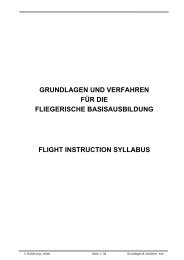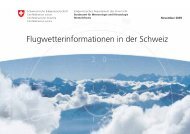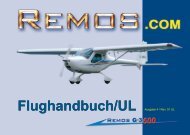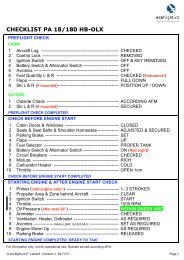Pilot Operating Handbook - Ecoflight.ch
Pilot Operating Handbook - Ecoflight.ch
Pilot Operating Handbook - Ecoflight.ch
Create successful ePaper yourself
Turn your PDF publications into a flip-book with our unique Google optimized e-Paper software.
Rev. 02 – July 16 th , 2009<br />
7 Normal Procedures<br />
7.5 Normal Take-Off<br />
1. Set flaps to 15° position<br />
(Take-off from concrete or hard surface runways can also be<br />
done with flaps in retracted position)<br />
2. Adjustable propeller in take off position<br />
(Not for ASTM aircraft certified in USA)<br />
3. Set electric trim to neutral position<br />
4. Swit<strong>ch</strong> on electric fuel pump<br />
5. Move rudder and elevator to neutral position (in crosswind<br />
conditions ailerons into direction of wind)<br />
6. Apply full power<br />
7. After rea<strong>ch</strong>ing a speed of about 50 mph (45 kts) gently raise<br />
the nose<br />
8. The aircraft will get airborne after exceeding a speed of<br />
about 65 mph (55 kts)<br />
The minimum engine speed for take-off:<br />
Propeller<br />
rpm<br />
Senseni<strong>ch</strong> 4.900<br />
Tonini 5.000<br />
Neuform 4.900<br />
Rospeller* 5.200<br />
(*) Not for ASTM aircraft certified in USA<br />
7.6 Best Angle of Climb Speed (V X )<br />
The best angle of climb is a<strong>ch</strong>ieved at an airspeed of 56 mph<br />
(49 kts). Monitor maximum CHT, oil and water temperature during<br />
long periods of climbing. Oil temperature regulation flap must be set<br />
to position "open" or "cooler".<br />
Normal Procedures 7 - 6










